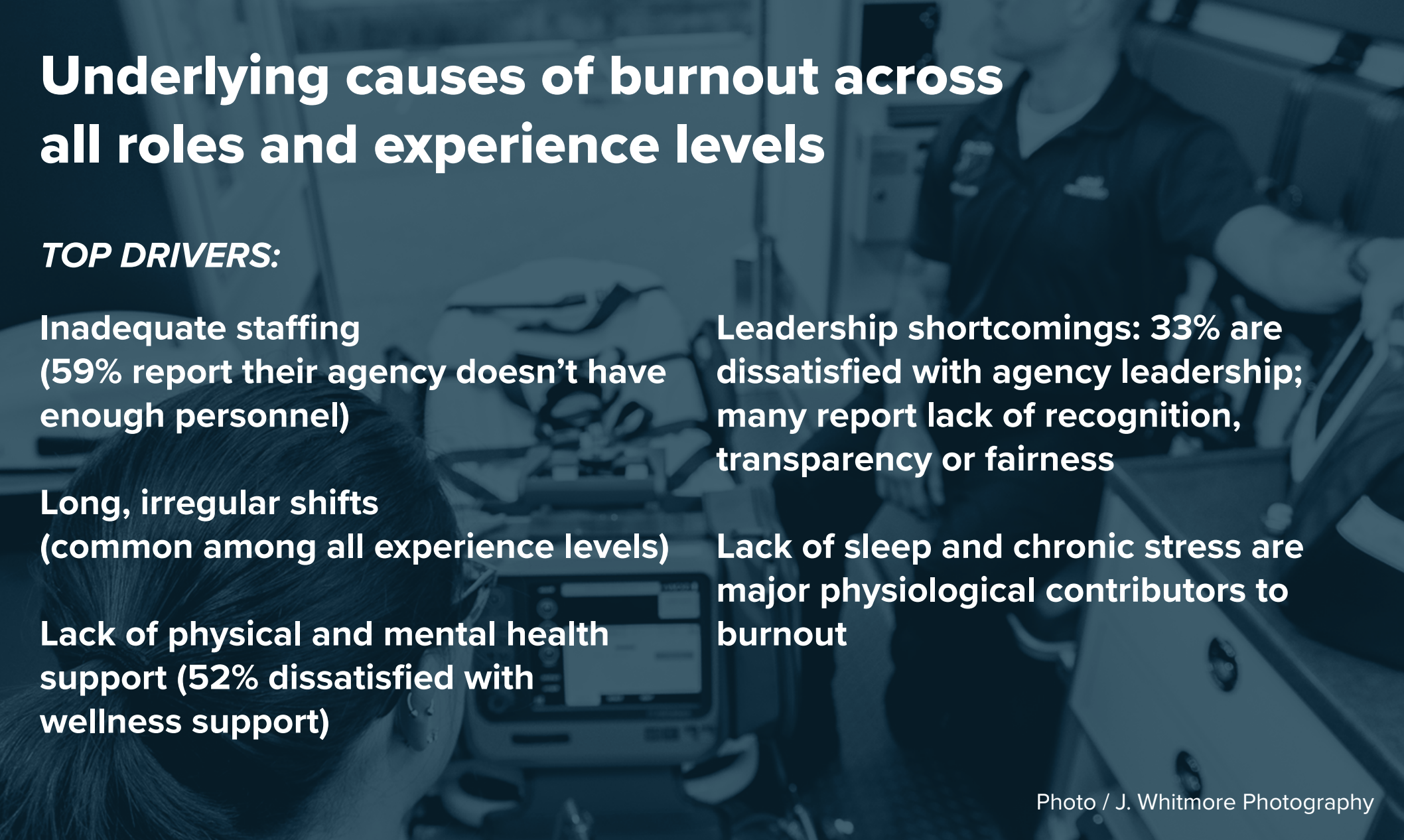Does Your Team Feel Unseen? Close the Leadership Disconnect with 2-Way Communication
Editor's Note: In July 2025, EMS1 and Fitch & Associates released their annual EMS trend survey, What Paramedics Want, proudly sponsored by Pulsara....
4 min read
 Team Pulsara
:
Nov 12, 2025
Team Pulsara
:
Nov 12, 2025
![Burnout in EMS: Recognize it, Fight it, Overcome it [2025 EMS Trend Survey]](https://www.pulsara.com/hubfs/stressed-female-paramedic-1200x630.jpg)
Editor's Note: In July 2025, EMS1 and Fitch & Associates released their annual EMS trend survey, What Paramedics Want, proudly sponsored by Pulsara. Because the articles and advice found within contain such critical subject matter, we've elected to publish each segment one at a time here on our blog. Read, enjoy, share, and take to heart the following information brought to you by the most prestigious thought leaders in EMS. Today's entry is written by Corinne Flammer, EMS mental health resilience officer for Saint Clare's Health.
_____
Burnout tops the list of critical concerns. Discover how to recognize the signs and address root causes, to prevent and reverse burnout.
Burnout—we’ve all heard of it, and many of us have felt its heavy weight. Whether whispered about among experienced providers or discussed openly in training sessions, burnout has become a defining concern in the EMS profession. In fact, in this year’s What Paramedics Want EMS Trend Survey, we added burnout as a potential response to the question, “Rank the critical issues facing EMS today,” and it shot to the top of the list.
But what exactly is burnout? How can we recognize it—in ourselves and in others—and, more importantly, how can we address it before it takes a permanent toll?
Burnout is a recognized medical condition with an ICD-11 classification. According to the World Health Organization (WHO), burnout is:
“A syndrome conceptualized as resulting from chronic workplace stress that has not been successfully managed... characterized by three dimensions:
Burn-out refers specifically to phenomena in the occupational context.”
This definition frames burnout as a serious occupational phenomenon—not a passing phase or mere dissatisfaction.

In EMS, where stress is a daily expectation, it’s essential to understand that burnout doesn’t arise from a single critical incident. Instead, it builds over time through chronic dissatisfaction, relentless demands and unaddressed emotional exhaustion. Even small, everyday stressors, when unrelenting, can push us toward burnout.
Recognizing burnout begins with assessing your overall happiness and satisfaction. Everyone has rough days, but if you find yourself persistently exhausted, emotionally detached or unable to find joy in any part of your shift, you may be experiencing burnout.
Small frustrations—like a missed lunch break—that once rolled off your back, now feel overwhelming. Jokes from coworkers that once made you laugh, now only annoy you. When nothing about the job feels rewarding anymore, that’s a major red flag.
Coworkers often spot the signs first:
These behaviors, while frustrating, are sometimes cries for help signaling deeper struggles with burnout.
If you’re experiencing symptoms of burnout, try these three strategies:
1. Reconnect with your “why.” One of the most effective antidotes to burnout is reconnecting with your purpose—your “why.” Why did you enter EMS? Was it to make a difference? To help those who couldn’t help themselves? To be part of something bigger?
Think back to the pride you felt when you passed the NREMT or state certifying exam, or first put on your uniform. Those moments of accomplishment were fueled by meaning and connection. Finding that sense of purpose again can be a powerful tool in pulling yourself out of burnout.
Don’t be afraid to ask a trusted colleague to help you remember your “why.” Conversations that foster workplace connection are proven to strengthen resilience.
2. Practice gratitude. Gratitude isn’t just a feel-good practice; it’s a scientifically backed tool to rewire your brain. Studies using fMRI imaging show that focusing on gratitude strengthens neural pathways associated with positive thinking.
Simple daily practices—like naming three things you’re grateful for after each shift—can gradually shift your outlook. Over time, positivity becomes your default setting, rather than negativity.
3. Step back to see the bigger picture. Taking time away is another critical strategy. Even short breaks or real vacations (not picking up extra shifts) provide valuable perspective. Distance allows you to reset, reflect and return with a renewed view of your role and career.

While individual strategies are important, burnout is also an organizational problem. Leadership plays a critical role in either contributing to or alleviating burnout among providers.
It’s telling that following burnout, the next critical issues concerning survey respondents were organizational: retention, funding and career development. Leaders must recognize that burnout isn’t just an individual failing—it’s often the symptom of systemic issues.
If you’re an EMS leader, here’s how you can start building organizational resilience:
1. Foster true transparency. Many survey respondents expressed frustration that leaders manage, but don’t truly lead. Closing that gap requires listening, involving employees in decision-making, and being open about challenges and solutions. When employees feel heard and see tangible changes, organizational trust—and resilience—grows.
2. Promote fairness. Opportunities for promotion and responses to mistakes must be consistent, fair and based on merit, not favoritism. Growth requires mistakes, and addressing them constructively, not punitively, fosters both learning and loyalty. Likewise, providing pathways for professional development strengthens employee engagement at every level.
3. Recognize good work. Positive reinforcement is powerful. Recognition—whether a simple “thank you” or formal awards—builds momentum. It strengthens employees’ connection to their work and can be the lifeline someone needs when standing at the edge of burnout.
The good news is that burnout doesn’t have to be permanent. Recovery begins with choice — the choice to address it, personally and organizationally. For individuals, it means rediscovering purpose, practicing gratitude and giving yourself space to heal.
For organizations, it means creating cultures of transparency, fairness and celebration.
Burnout is real—but so is resilience. Together, we can rebuild not only ourselves, but also the EMS profession into something stronger and more sustainable than ever.
Download the full digital edition: What Paramedics Want 2025
Corinne Flammer is New Jersey’s first EMS mental health resilience officer for Saint Clare’s Health, in Denville, New Jersey. She has over 30 years of EMS experience as a paramedic, educator and FTO. She is a sought-after speaker, author and podcast guest, as she shares her passion for first responder mental health. She holds a master’s degree in psychology, focusing on trauma and crisis response.
For EMS teams, effective use of communication tools is critical. When everyone is on the same easy-to-use platform, caregivers can collaborate across organizations and save vital minutes when they matter most. To learn more, check out 10 Ways Pulsara Helps During Time-Sensitive Emergencies.

Editor's Note: In July 2025, EMS1 and Fitch & Associates released their annual EMS trend survey, What Paramedics Want, proudly sponsored by Pulsara....
![[PRESS RELEASE] Published Research Finds Up to 31% Faster STEMI Treatment Times in Rural Hospital Setting with Pulsara](https://www.pulsara.com/hubfs/_1_website-page-blog-assets/pulsara-hosp-teams-assign-cardio-stemi-rn-1200x701.jpg)
Published research shows how using Pulsara, alongside standardized field activation and a focus on stakeholder relationships, improves STEMI care and...

Editor's Note: In July 2025, EMS1 and Fitch & Associates released their annual EMS trend survey, What Paramedics Want, proudly sponsored by Pulsara....